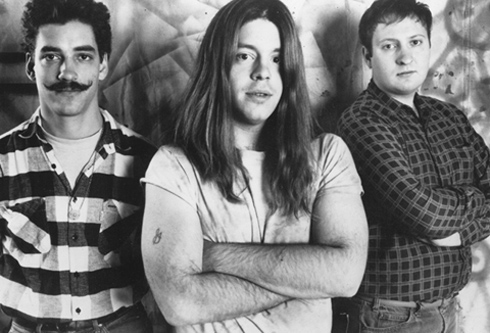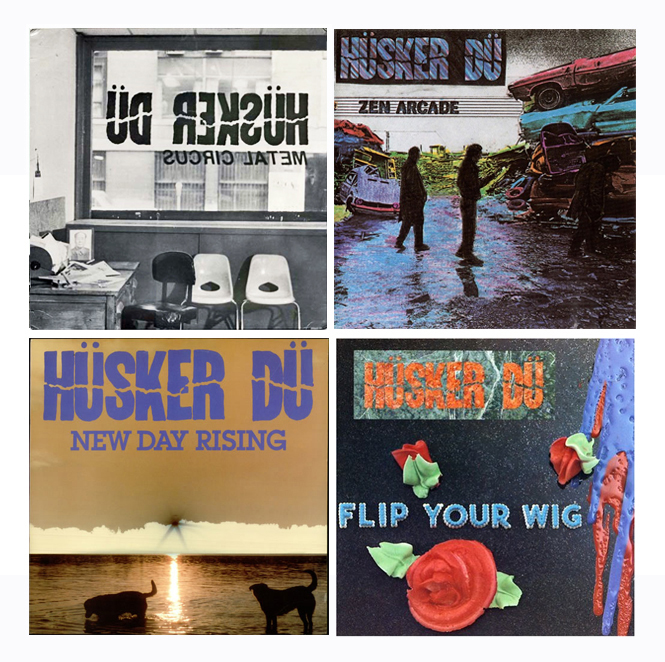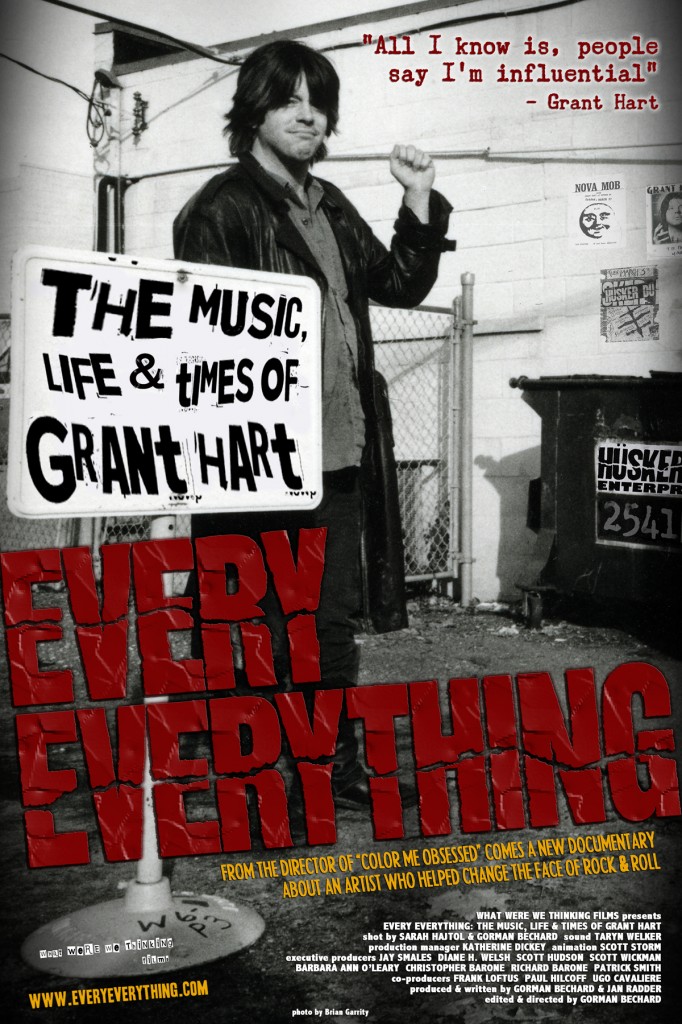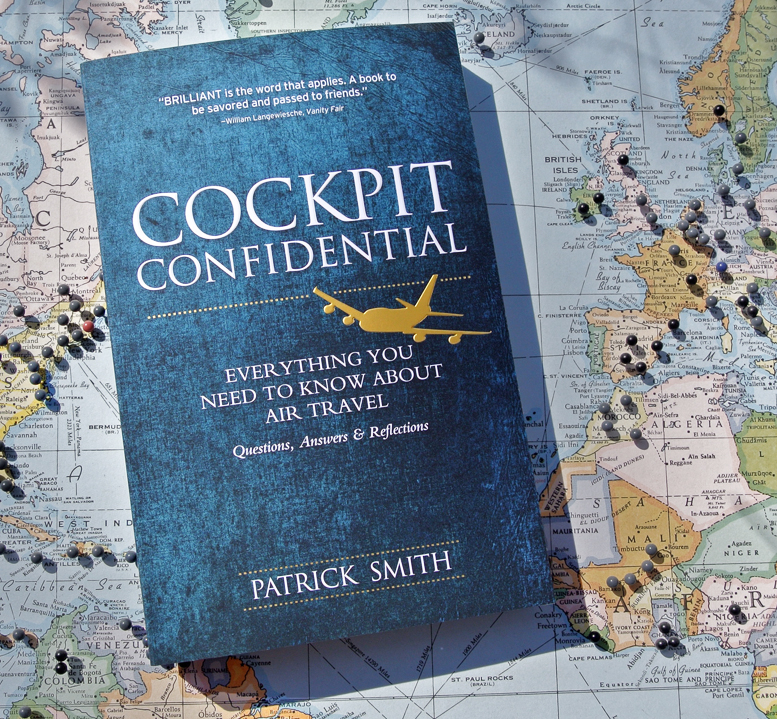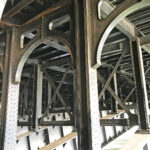Q&A With the Pilot, Volume 5

AN OLD-TIMEY QUESTIONS AND ANSWERS SESSION.
Eons ago, in 2002, a column called Ask the Pilot, hosted by yours truly, started running in the online magazine Salon, in which I fielded reader-submitted questions about air travel. It’s a good idea, I think, to touch back now and then on the format that got this venerable enterprise started. It’s Ask the Pilot classic, if you will.
Q: Flying out of Pittsburgh the other day, about ten minutes after taking off, the pilots deployed the landing gear for about ten seconds, then retracted it again. Nothing was said over the PA. Why would they have done this?
The pilots may have had an indication of hot or overheated brakes. Brakes can heat up during taxi, and stay hot after takeoff. The checklist might call for momentary deployment of the landing gear to help them air-cool. Or, it might have been a landing gear door not in its proper position. Again, the checklist might call for “cycling” of the landing gear.
Neither of these things is especially urgent, which would explain why they waited until 15,000 feet. The first few minutes after takeoff are quite busy.
What’s not explained is why the crew didn’t say anything. I suspect a majority of passengers would realize that dropping and retracting the gear at 15,000 isn’t normal. A quick PA was due.
Q: Prior to landing, the pilots told us they’d be lowering the landing gear much earlier than usual in order to help burn off excess fuel. I had never experienced this before
This happens rarely, but it does happen. It sounds as though your plane may have been above its maximum landing weight for the runway in use. Perhaps the flying time turned out to be significantly shorter than planned. Or, maybe, due to weather or some such, the only available runway was a shorter one than expected. Your weight determines your landing speed, which in turn affects how much distance you need. The increase in drag from dropping the gear early would significantly increase fuel burn. It’s extremely wasteful, but it works.
Larger jets have fuel jettison capabilities, but that’s more for emergency returns, medical or mechanical diverts — that sort of thing. And some planes have exemptions that permit overweight landings up to a certain point, usually requiring a post-flight inspection.
Q: When we landed in Chicago, the pilots told us we were headed into the “penalty box” because there was no available gate. We pulled over, parked, and waited over an hour. What is this penalty box?
That’s just a playful term to describe some spot on the tarmac where, for whatever reason (ATC delay, occupied gate) you’re asked to sit. An airport might have a designated area used for the purpose. Or, more often than not, it’s just an improvised location. The other night at JFK we waited about 45 minutes for a gate to open; the ground controllers sequestered us on a quiet taxiway between two runways.
Q: Okay, we’re sitting in the penalty box and the crew says our gate isn’t available. Yet I clearly see one or more wide-open gates at the terminal. Why can’t we use one?
Yes, I know, this happens all the time. Occasionally you’ll be swapped into one of those open spots, but if not, it’s normally because other inbound flights have dibs on them. Once you start swapping parking spots around at the last minute, you put a lot of different parts in motion (baggage and cargo loading and unloading, and so on), which leads to screw-ups further along. And what time a flight is do out has a lot to do with which gate it needs to use on the way in. It’s a matrix. I’ve had conversations with the apron staff about this, and came away realizing it’s not as simple as it seems.
Keep in mind, too, that the gates you see out the window might belong to another carrier. In the U.S. most gate space is proprietary. American doesn’t use United’s gates, or vice-versa. Their facilities, and the personnel that run those facilities, are separate — unlike in other parts of the world, where gates and concourses often are shared.
Q: I was watching the ramp crew give hand signals to the pilots as a jet was pulling in to the gate. Some of the gestures were obvious, like the guy at the nose moving his batons closer together until they crossed, telling the plane to stop. But why did the same guy raise his arms and flash four finger, two or three times in rapid succession? What did that mean?
He was telling the pilots that the plane’s landing or taxi light was still on, and was perhaps shining in his face. The taxi lights are usually located on the nose gear strut, and we switch them off once we turn into the parking bay to avoid blinding the marshaler. Occasionally if there’s a lot activity or we’re busy looking outside, we forget.
EMAIL YOUR QUESTIONS TO patricksmith@askthepilot.com
Related Stories:
Q&A WITH THE PILOT, Volume 1
Q&A WITH THE PILOT, Volume 2
Q&A WITH THE PILOT, Volume 3
Q&A WITH THE PILOT, Volume 4
Q&A WITH THE PILOT, Volume 5
Q&A WITH THE PILOT, Volume 6
Q&A WITH THE PILOT, COVID EDITION
Portions of this post appeared previously in the magazine Salon.

Happy Birthday to the (Second) Greatest Album of All Time
IT WAS DECEMBER 30th, 1984, and Hüsker Dü were in from Minnesota again. They’d just wrapped up a show at a small auditorium in Concord, Massachusetts, and a small group of us were backstage talking to guitarist Bob Mould and drummer Grant Hart — the band’s co-vocalists and songwriters. A brand new album was due to hit the stores in only a week or two, and we all wanted to know: what was it going to sound like?
Zen Arcade had come out that past summer, and the indie rock world was still trying to absorb it. “Experimental” isn’t quite the right word, but Zen had played fast and loose with the boundaries of what punk rock, for lack of a better term, was supposed to sound like, bringing in acoustic guitar, piano, and a range of psychedelic effects. The upcoming project, it stood to reason, would take things ever further, would it not? Somebody — maybe it was me — brought this up.
“No way!” laughed Hart.
“Not at all,” added Mould. “This album is more like Land Speed Record than Zen Arcade!”
Land Speed, from way back in 1981, was a thrashy collection of quasi-hardcore songs played at nearly supersonic speed. Mould was being tongue-in-cheek — the album wouldn’t sound anything like Land Speed — but just the same he was dropping a hint: this wouldn’t be a record for the squeamish.
It was called New Day Rising — a remarkable fifteen-song LP that would wake the country from its winter freeze in January of ’85. There is nothing subtle or subdued about this album. There are no touchy-feely instrumentals, no acoustic time-outs — enjoyable as those things were on Zen. Sure, the melodies and catchy choruses are there beneath it all, in typical Hüsker fashion, but New Day Rising is power from start to finish; forty fearless minutes of ferocious exuberance.
I’m not going to argue that Zen Arcade isn’t the better or more important album. It’s all the things the pundits have called it from the start: monumental, groundbreaking, a reevaluation of everything we thought punk rock could or should be. It’s a masterpiece. But almost too much of one, moody and broody at times, and a little too — what’s the way to put it? — serious. New Day is the brasher and looser album, with Mould and Hart clearing out the pipes, with nothing left to prove and absolutely hitting their strides. It is, if nothing else, the most supremely confident-sounding album of all time.
And it’s made all the more so through a daring, some might say controversial sound mix. There’s a very particular sound to this album — a treble-heavy mix that is like nothing before or since, in which every song is enveloped in a fuzzy, fizzing, needles-pegged curtain of sound. Many people — including the band members themselves, reportedly — have always rued this peculiar mix, but to me it’s the ideal vehicle for the group’s sound. Here is the “Hüsker buzz,” as I call it, naked and cranked to eleven. (What I wouldn’t give to hear some of the cuts from Zen Arcade or Flip Your Wig** remixed like this.) The style is “hot” in soundboard lingo, but to me it has a crystalline, sub-zero quality: it sounds like ice. The songs are as melodically solid as any top-40 hits of the time, but all whipped up in a great Minnesota blizzard.

Greg Norton, Grant Hart, and Bob Mould, in 1984.
Photo by Naomi Petersen.
First time listeners will know exactly what I mean within the first ten seconds of the title cut. “New Day Rising,” the song, begins with a lead-in of anxious drumming — Hart pounding away, as if to say “Let’s this this fucking thing started!” — and then comes the crescendo, a guitar-blast crashing over you in a huge squalling wave: equally furious and melodic; chaotic yet strangely orchestral. It’s a breathtaking opening and the perfect pace-setter for the rest of the record. (Robert “Addicted to Love” Palmer once found it a compelling enough song to cover.)Next up Hart’s “Girl Who Lives on Heaven Hill.” There’s something sour and vaguely out of tune about this song that for years I could never get past. Until one day it hit me: it’s supposed to be like that. Hart takes the all the nicety and sing-songy pleasures of “It’s Not Funny Anymore” or “Pink Turns to Blue” — songs that are almost too easy to like — and twists and bends and sets fire to it. Then, between the second and third stanzas, Mould comes in with a guitar solo that tears the rest of it — along with your eardrums — to pieces. It’s a haunting, mesmerizing, and a little bit frightening three minutes.
The third cut is Mould’s “I Apologize.” This is arguably the best song he ever wrote, perhaps outclassed only by the “Eight Miles High” cover, or by “Chartered Trips” from side one of Zen Arcade. Here is the song Green Day and its ilk only wish they could have made: poppy and powerful, but without the slightest hint of heavy metal pretension. And is it just me, or you can you almost hear Michael Stipe singing this one? The chorus is uncannily infectious in the style of old REM songs of the same era. It’s as if you took a song like “South Central Rain” and split every atom of it: all that sweet Georgia lilac exploded into a sort of nuclear ice storm. (Putting Hüsker Dü and REM in the same sentence might seem incongruous, but it’s not by accident that they once toured together.) Listen to “I Apologize” here. Don’t skip the final fifteen seconds, and play it loud.
Further along is one of the great sleepers in the Hüsker Dü canon: Mould’s “Perfect Example.” This is the record’s only true “slow” moment — the band’s idea of a tearjerker. It closes out side one, sung by Mould in a kind of passive-aggressive whisper, with Hart (barefoot no doubt, as he always played) double-thumping the bass drum in perfect synchronicity to a human heartbeat. The song clashes to a close on the word “perfect.” Had the album ended right there, already it’d be a classic. Except that’s only the first side.
Although only two of the cuts are his, Grant Hart effectively owns side two. This is by virtue of “Terms of Psychic Warfare” and “Books About UFOs,” both of which are unforgettable. Listen to “Terms of Psychic Warfare” here, with its signature bass riff and beautifully cascading vocals.
The better one, though, is “Books About UFO.” Equal parts deafening, frenetic, melodic and catchy, the track is backed with piano. From any other band, in any other context, this effect would probably sound gimmicky. Not so here. Indeed, it’s almost as if this song were written for piano from the start. “For all the speed and clamor of their music,” the music journalist Michael Azerrad once wrote, “Hüsker Dü was perhaps the first post-hardcore band of its generation to write songs that could withstand the classic acid test of being played on acoustic guitar.” That’s an excellent point, but the heck with that, I want to hear Grant playing an all piano version of “Books About UFOs.”
“I’d also recorded a slide guitar on ‘Girl Who lives on Heaven Hill,'” Grant Hart remembers. “But when I showed up after that session, Spot [the album’s co-engineer] and Bob issued an ultimatum: either the piano goes from ‘UFOs’ or the guitar goes from ‘Heaven Hill.’ After stating my case, which was ‘what does one have to do with the other?’ I relented and said if one had to go, let it be the slide guitar.
Probably the right decision. “UFOs” is one of the most furiously pretty, and downright interesting songs you’ll ever hear.
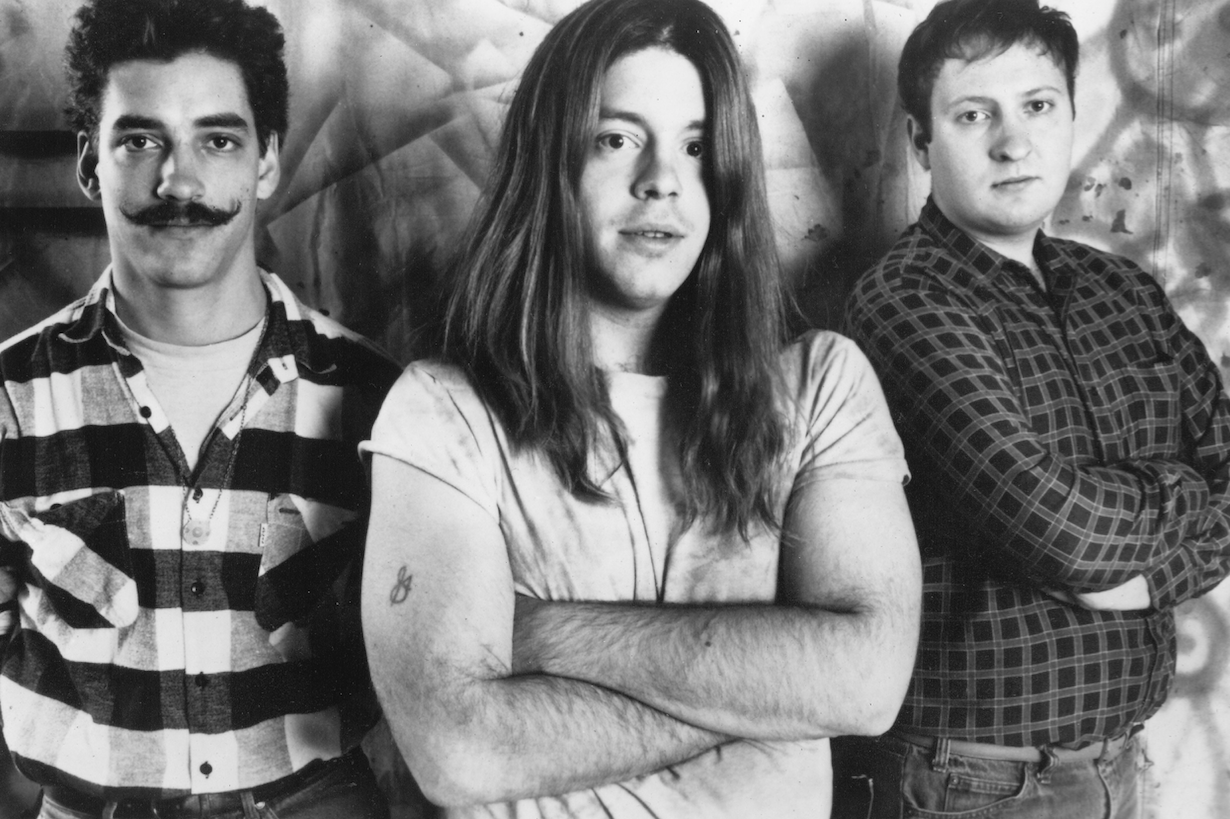
Norton, Hart, and Mould.
Photo by Daniel Corrigan.
To the end, Hart, who passed away in 2016, held some strong resentment against the way Spot, who’d been sent to Minneapolis from Los Angeles by SST Records to oversee the project, handled his duties. Spot shared the engineering tasks with the band members and their longtime collaborator Steve Fjelstad, but as Hart once explained it, “SST decided that we were not to be the masters of our own destiny, and sent Spot to babysit/spy/sabotage our record. He did not give Steve Fjelstad the respect he deserved, treating him as an assistant.””Another thing I remember,” said Hart, “was not being allowed to make my own choices as far as re-doing vocals that I thought I could better. On ‘Heaven Hill’ you could hear the sound of some lumber, that had in been in the booth during remodeling, falling to the floor!”
Well, all of that aside, it’s tough to have too much issue with the finished product.
The album comes to an end with the charging, spiraling, sonic immolation of Bob Mould’s “Plans I Make.” Fasten your seatbelts for this one. It’s not the jammy, psychedelic marathon of “Reoccurring Dreams,” the 14-minute instrumental that closes Zen Arcade, but it’s a wringer, an earsplitter that, when it finally crunches to its conclusion, leaves the listener with no choice but to sit spellbound for a time.
If it seems like only yesterday that I was writing about the 30th anniversary of Zen Arcade, which had been released in June of 1984. It’s fascinating testament to Hüsker Dü’s talent and tireless work ethic that two such brilliant albums could have been released within a mere seven months of each other. And these were bookended, I should add, by two other highly impressive records — Metal Circus and Flip Your Wig, from October of ’83 and September of ’85 respectively. A spectacular four-record punch in a span of under two years.
And if forced to choose, I’d say New Day Rising sits the pinnacle of that run. This is Hüsker Dü at the very apex of its career, and one of the finest moments in the whole history of what used to be called underground rock.

Meanwhile, unless I’ve missed something, none of the big music magazines or websites gave New Day so much as a mention on its 20th, 15th, or 30th birthdays. For that matter, do younger music fans have any sense of what the 1980s truly were like? This was the richest and most innovative period in the whole history of independent music, but rarely is it acknowledged as such. As popular culture has it, serious rock music skipped the 80s entirely. When pundits do take the decade seriously, we tend to see the same names over and over. It’s both frustrating and unjustified that Hüsker Dü never developed the same posthumous cachet that others of their era did. Like the Replacements, for example, or Sonic Youth. Hüsker Dü could run circles around either of those two, but never became “cool” in quite the same way.
I suppose it’s due to a total absence of what you might call sex appeal? To say that Hüsker Dü never cultivated any sort of image, in the usual manner of rock bands, is putting it mildly. For one, they never looked the part. These were big, sweaty, chain-smoking guys who, it often seemed, hadn’t shaved or showered in a while. Norton, trimmest and most dapper of the threesome, wore a handlebar mustache many years before such things were trendy among hipsters. It wasn’t cool; it was odd. And not until their eighth and final album that the band include a photo of itself on an album cover (the scratched-out images on Zen Arcade notwithstanding).
This modesty, for lack of a better description, was for some of us a part of what made Hüsker Dü so special. But it has hurt them, I think, in the long run.
The idea that the Replacements (much as I loved their debut album, which I consider the best garage-rock record of all time, and which includes a shout-out called “Somethin’to Dü”) were in any way a better or more influential band than Hüsker Dü is too absurd to entertain. Meanwhile the beatification of Sonic Youth, maybe the most overrated outfit of the last forty years, goes on and on. Not long ago Kim Gordon got a profile in the New Yorker. I’m still waiting for one of the writers there to devote a story to Bob Mould.
Or better yet, to Grant Hart. Twenty-five years, more or less, that’s how long it took me, to realize that it was Grant, not Bob, who was the more indispensable songwriter and who leaves the richer legacy. In the old days it was trendy to claim that Grant was the real genius behind Hüsker Dü. You’d be at a party and some asshole would say, “Those guys would be nothing without that drummer.” I’d always scoff that off. The mechanics of the band, for one, made it difficult to accept: Grant was the drummer, after all, and drummers are never the stars. And there was Bob, right at the front of the stage with that iconic Flying-V. But those assholes were on to something.
That shouldn’t be an insult to Mould. Not any more than saying Lennon was a better songwriter than McCartney. Both were brilliant. But when I flip through the Hüsker canon, I can’t help giving Hart the edge. There’s a soulfulness to his songs sets them apart. They’re not necessarily “better” so much as they resonate in a different and deeper way. On New Day Rising, Mould gave us “I Apologize” and “Celebrated Summer.” But Hart gave us “Terms of Psychic Warfare” and “Books About UFOs.” On earlier records it was “It’s Not Funny Anymore,” “Diane,” “Pink Turns to Blue,” the list goes on. Hart’s “She’s a Woman (And Now He is a Man”) from the often intolerable Warehouse album is, to me, a classic sleeper and the most under-appreciated Hüsker song of them all.
His solo work, too, was at least as robust as that of Mould. Songs like “The Main” and “The Last Days of Pompeii” are as good or better than anything Mould has given us post-Hüsker. But while Mould went on to some notoriety and commercial success, Hart labored in comparative obscurity. This was always irritating and unfair.
But Grant, maybe, was all right with this. “I have always based my movements on those of fugitives or criminals,” he once said to me. “The less attention you attract, the freer you remain! I wish to be an artist, not a celebrity.”
Related Story:
Now and Zen. The Greatest Album of All Time Turns 30
Happy Birthday to the Greatest Album of All Time
HüSKER Dü WERE A TRIO from Minneapolis. Guitarist Bob Mould and drummer Grant Hart sang and wrote the songs. Greg Norton played bass guitar and chipped in on vocals.
A punk band, you would have to call them, as throughout the early and mid-1980s they toured and recorded primarily within that realm. At heart, though, they were always something else. “Hüsker Dü seemingly defined the punk ethos,” wrote Terry Katzmann, one of the band’s longtime friends once put it, “without necessarily embracing or endorsing it.” Perfectly put.
The band could play louder and faster than anyone alive. When this got constraining, they’d bring in 60s-style pop hooks, psychedelia, heavy metal. Often at once, which to me is the kernel of what made them great. They were never powerful or something else. They were both, everything, all at the same time.
This blending of styles alienated many of the more orthodox fans within the punk scene. It also won the acclaim of many more, and it’s by no means a stretch to consider Hüsker Dü one of the most influential acts ever to emerge from the American underground.
Before its stormy demise in late 1987, the band would release six full-length albums, two EPs, and a catalog of singles and extras. But the pinnacle of all that output was Zen Arcade, first delivered to stores in July, 1984, by California-based SST records.
I remember the day I bought it. Newbury Comics — the one on Newbury Street — on a midweek afternoon, sunny and hot. I was eighteen years-old.
We knew there was an album coming coming out, but weren’t sure when, exactly, it would hit the racks. In these pre-Internet times, news of such things was always unclear and came sporadically, delivered by college radio or gleaned through your network of friends. Sometimes it was a paper flyer glued to a mailbox or tacked to a record shop bulletin board. Nobody was a bigger Hüsker Dü fan than I was, but this latest album, due in the stores at any moment — I didn’t even know the title.
Suddenly there it was, on a rack up front. It was called Zen Arcade, whatever the heck that meant. I picked it up and, hey, what’s this, it’s a double album! As a teenage punk rocker weaned on Black Flag and Minor Threat, with a rather one-dimensional appreciation for music, the very weight of the thing, together with the heady title and the washed-over, almost Impressionist cover art was intimidating. It seemed so arty and grown-up. It also made me curious. What was this strange record?
What it was, and what it remains almost forty years later, is the greatest indie-rock album of all time — if not, in my extraordinarily biased opinion, the greatest rock album, period.
“The most important and relevant double album to be released since the Beatles’ White Album,” bragged SST’s own press release. There was some confidence for you, to say the least, when you consider the world of underground music in 1984. This was not only an obscure band, but an entire musical domain that existed far below the mainstream waterline. Then as now, the idea of comparing a little-known indie band to the Beatles seemed at best pretentious and at worst totally absurd.
Was it?
Twenty-three songs is a lot of music, but this is one the rare two-record sets that isn’t bogged down by its own overreaching or conceit. The scourge of most double LPs, back when there was such a thing, is they went on for too long — padded with live cuts, covers, and extras (heck even London Calling has its throw-aways). There’s no filler in Zen Arcade. Each and every song, from the shortest (44 seconds) to the longest (14 minutes), belongs exactly in its place.
Yes, that includes “The Tooth Fairy and the Princess.” The longest-named song on the record is probably the most easily dismissed. But it’s a clever little tempest of a song, littered with switchbacks and melodic explosions.
The album is best savored not as a CD — and for heaven’s sake not as a download — but in the old, cardboard-and-vinyl package. That’s a quintessentially record-snobbish thing to say, but unavoidable in this case, where each of the four sides is a distinct chapter with its own temperature and architecture.
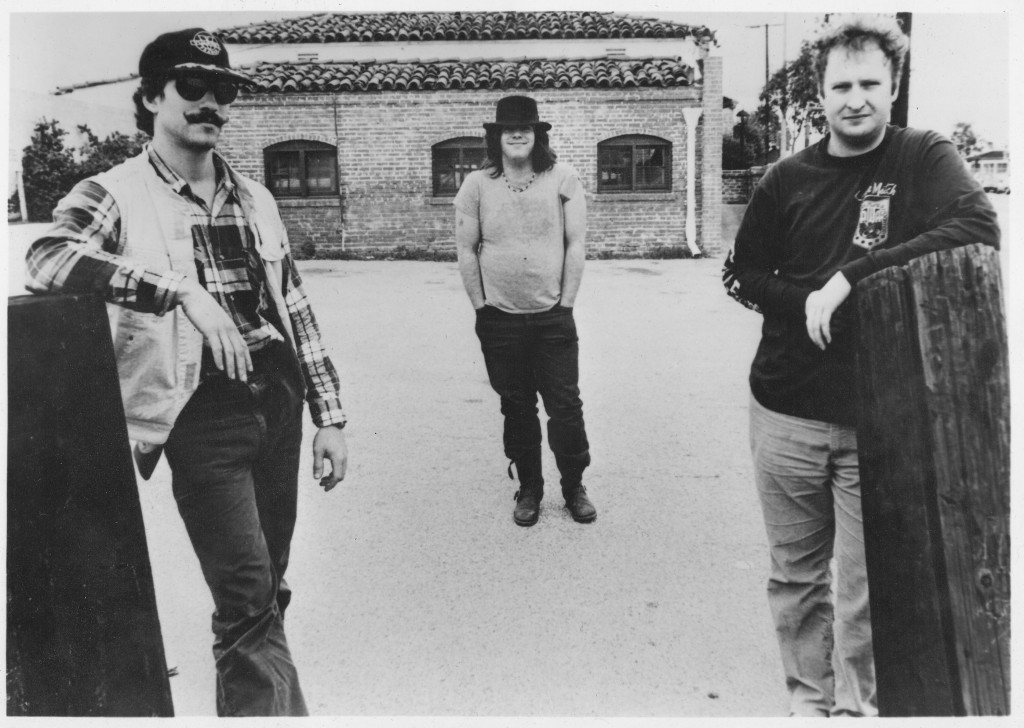
Greg Norton, Grant Hart, and Bob Mould, circa 1984.
Photo by Naomi Petersen.
Side one gets going without the slightest fuss, with the snap and kick of Bob Mould’s “Something I Learned Today,” eventually winding down with “Hare Krsna,” a booming, tambourine-backed instrumental (mostly).
The first time I heard “Hare Krsna,” sizzling over the stereo in a Boston area record shop not long after the album’s release, I remember the young clerk furrowing his brow, looking up toward the speakers and saying, “Somebody needs to write a dissertation about this song.” I couldn’t care less if they were plagiarizing a Bo Diddley riff; “Hare Krsna” is a mesmerizing, three-and-a-half minute cyclone of melodic chaos that still gives me the chills. Listen to Mould hitting the strings at time 0:44.
Side one alone is unforgettable. And there are three more to go. This is the ultimate workhorse album from the ultimate workhorse band, one so rich with sonic nooks and crannies that an in-depth listen leaves you not only battling tinnitus, but tired. So many changes from fast to slow, hard to soft, love to hate, all in perfect working sequence. And each side-break is a perfectly placed respite. I can’t think of a more brilliantly arranged opus than Zen Arcade. “The closest hardcore punk will ever get to an opera,” wrote David Fricke of Rolling Stone.
Indeed, this is a proverbial concept album — a musical story, in the spirit of the Who’s Tommy, allegedly describing the journey and tribulations of a young man. He leaves home, maybe joins a cult, maybe joins the Army…whatever. Alt-rock historians love reminding us about this, but you’re free to ignore it. Any lyrical backstory is incidental to the record’s impressiveness.
You’ll find a gamut of effects: acoustic guitar, chairs being thrown, waves breaking, whispers and chants. There’s even the breezy piano of “Monday Will Never be the Same.” (If Ken Burns ever directs a documentary about the history of alt-rock, the tinkling of “Monday” needs to be its backing theme.) Such eclectics are brave, maybe, for what was supposedly a punk album, but they never become maudlin or melodramatic. If you think today’s co-opted rockers are clever with the tempo card, shifting from tough to tender, check out Grant Hart’s “Never Talking to You Again,” a sing-along from side one done entirely in 12-string acoustic. “Heartfelt” is the word that jumps to mind, but it’s not the syrupy strum you’d hear nowadays. The song is biting and sharp — an attack. Ditto for “Standing By the Sea,” with Hart’s cathartic bellows set against bassist Greg Norton’s eerie thrum and the soothe of a crashing surf.
Back in ’84, the rock critic Robert Christgau chose Hart’s “Turn On the News,” from side four, as his “song of the year.” Christgau said many flattering things about Hüsker Dü, but that one was the gimmie pick, like saying the Concorde is your favorite airplane. It’s an easy song to like, but an even easier one to outgrow. If the album has a best song, it’s probably Bob Mould’s neo-pscychedelic “Chartered Trips,” the fourth cut off side one. (“Trips” is almost Mould’s single greatest work, topped only by his spectacular rendition of the Byrds’ “Eight Miles High,” released as a single just prior to Zen Arcade.)
Runner-up would be Hart’s “Pink Turns to Blue,” from side three. Officially the credits for this one list both Mould and Hart, but really this is Grant’s piece. He took all the hook and melody of his earlier masterpiece, “It’s Not Funny Anymore,” and sandblasted it into a haunting anthem of love, drugs, and death. The song is simply gorgeous — and a little bit terrifying. Score it ahead of “Chartered Trips” if you want. I’m not going to argue.
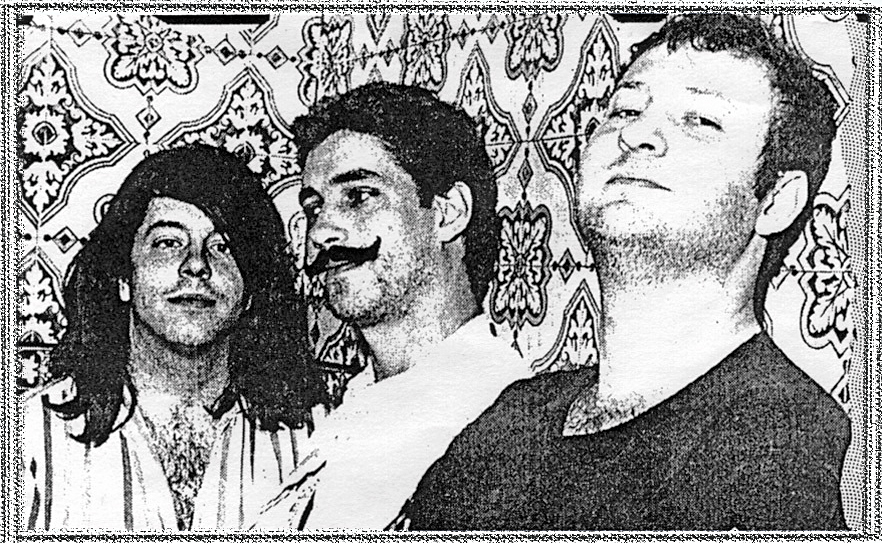
September, 1984, in the dressing room at the Channel.
Boston Rock magazine.
“Pink Turns to Blue” follows “One Step at a Time,” a brief piano time-out that, as much as anything else, allows the listener to catch his or her breath. The pregnant pause between the last note of “One Step” and the opening chord of “Pink” is like those one or two seconds between a lightning bolt and a thunderclap, and is one of the record’s strongest moments. It reminds me of the similarly unforgettable transition into “Sweet Jane” on the Velvet Underground’s Loaded album.
Before going further, I’m aware how this favorite songs thing can turn tedious pretty quickly. Grant Hart himself once offered a disclaimer: “People will always embrace different songs for different reasons,” he told me. “A song that might seem terrible filler, serving only to move the story along, will be someone’s favorite on the album. Bob and I were both responsible for those kind of songs.” Of my beloved “Hare Krsna” Grant claims that he was merely “furthering the story without adding much musically.” Hart felt similarly about some of Mould’s thrashier and more “hardcore” material.
To his point, not all of the album is easy to like and, depending on your ear and level of patience, the value of certain songs might not reveal itself for some time. For me it was twenty years before the first four songs from side two (Mould at his most furious) finally clicked. They’d always been so noisy and formless. Suddenly they weren’t. This was partly a context thing, maybe: the album, like wine, getting better not despite its age, but because of it. It took the overall shittiness of music in the 21st century to underscore the greatness of cuts like “Pride” and “The Biggest Lie” — mere footnotes in 1984. They’re awesome songs, at once explosive and subtle, but buried amidst so many other and perhaps better choices, that even the band’s most devoted fans tend to skip them over.
Similarly it was decades before I learned to appreciate “Broken Home, Broken Heart,” the second song on the album, for the gem that it is, tucked anonymously between “Something I Learned Today” and Hart’s “Never Talking to You Again,” with Norton’s bass stealing the show. And that a supposed punk rock album could jump from the fury of “Broken Home” to the acoustic beauty of “Never Talking”, without so much as a flinch, was a watershed in American music.
Though not entirely a surprise. Even at breakneck velocity there always was something ineffably refined and just, well, different about Hüsker Dü. If pressed to explain, one might break out 1982’s Everything Falls Apart EP. Amidst side one’s hypsersonic avalanche is Hart’s cover of Donovan’s 1966 hit, “Sunshine Superman.” Playful, perhaps, on the face of it, until you hear how un-ironic the remake is, without a note’s worth of smirk or parody. This wasn’t a joke. They were serious.
Later, on his solo tours, Bob Mould would often play acoustic versions of some of the hardest and fastest Hüsker Dü songs — cuts like “In a Free Land” or “Celebrated Summer” — and the results were startlingly pretty. That’s just not going to work if you’re Black Flag, the Dead Kennedys or Bad Brains. Or Nirvana. Run even the noisiest Hüsker song through a centrifuge and something elegant reveals itself.
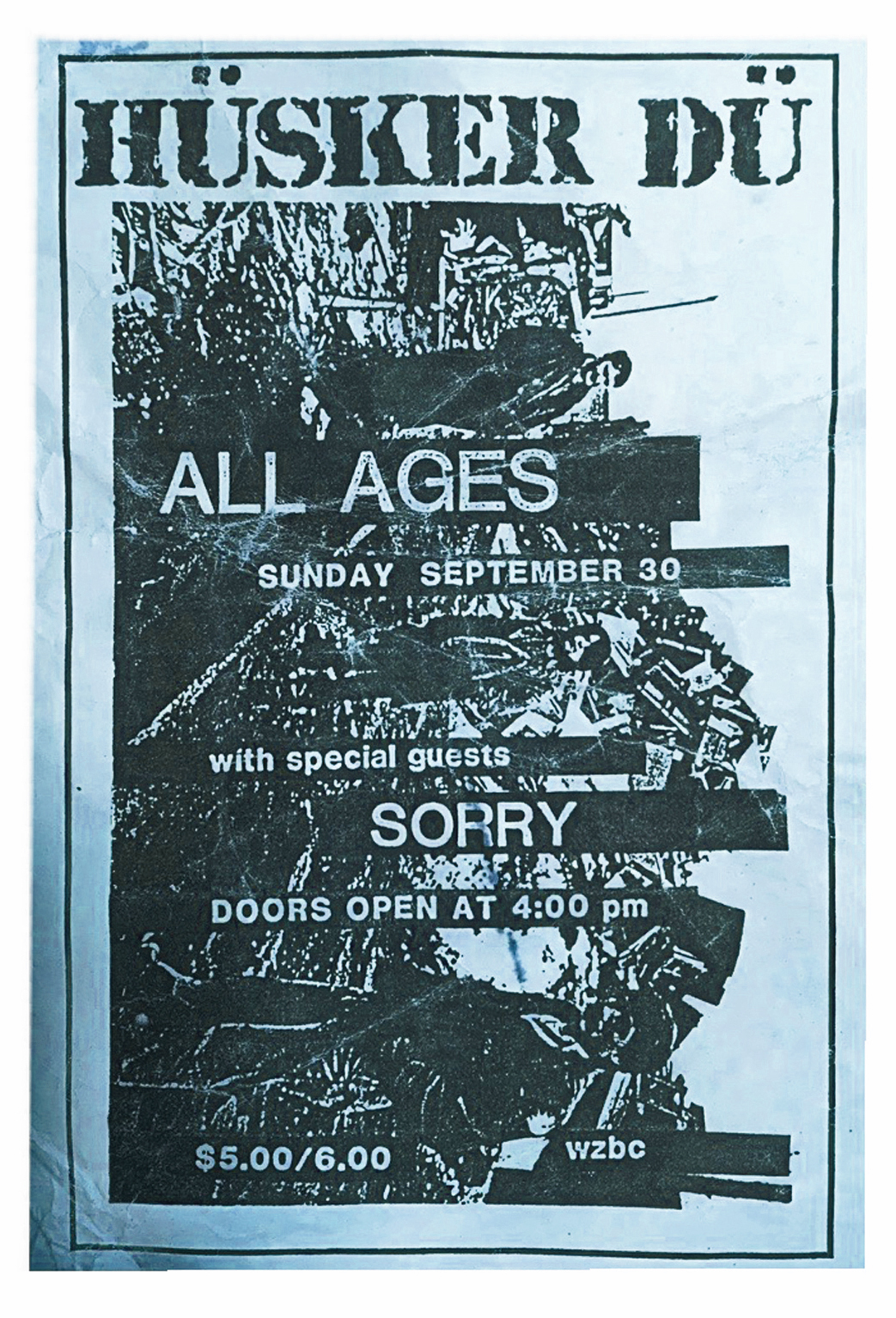
Concert flyer, Boston, 1984. Author’s Collection.
With its blend of hippie love and hard rock thunder, Zen Arcade would, in a way, finish the job that the Velvet Underground and even the Beatles had tinkered with earlier. But while the blending of power/pop extremes was nothing new, the Hüskers pulled it off in a way that was never gimmicky (not until their lazy cover of “Love is All Around,” the Mary Tyler Moore Show theme, in 1986), and, most remarkably, did so on such terrain –- the American hardcore punk scene –- where nobody expected it or even believed it possible.
“A strenuous refutation of hardcore orthodoxy,” as Michael Azerrad puts it in his book, Our Band Could Be Your Life: Scenes from the American Indie Underground, 1981-1991. “Zen Arcade was the final word on the [punk rock] genre, a scorching of musical earth. The album wasn’t only about Hüsker Dü coming of age — it was about an entire musical movement coming of age.”
Zen Arcade is the album Nirvana and its contemporaries only wish they could have made: intelligent, clamorous, and hashing out more torment and passion in four sides than all the grungers and headbangers since. All without a hint of heavy metal pretension: to think anyone could concoct a fourteen-minute bombast of guitar leads and layered distortion — “Reoccurring Dreams,” side four — and have it not come out self-indulgently.
All right, maybe it’s a little self-indulgent. But listen carefully enough and you’ll learn that “Dreams” can be parsed into six or seven subsections, each of them breaking through to the next, right in the nick of time. The song is long, but never wears out its welcome. It belongs there, in its entirety. An epic album deserves an epic close.
And when the 40-second whine at the end of “Dreams” is at last pinched off, the album burning to a close in a congealed, numbing squeal, the silence that follows is palpable, as dramatic as any of record’s loudest moments. Only then, as your senses regain their composure, is it apparent that your notions of punk rock are changed forever.
But not everybody, however — not even Grant Hart — has openly accepted such lavish praise. Hart once described Zen as the album that fans “tend to wear on their sleeves.” Did he mean people like me? Have I been too sentimentally fond of it for some reason?
“The impact of Zen Arcade on the Zeitgeist is hilarious to me,” said Grant. “Hilarious in the almost alchemical-mechanical way it has been embraced by true music fans and hipster-flipsters alike. When somebody states that Zen is their favorite LP, I get the notion to ask why. As we move further from the time it was released, it seems I get more honest answers.”
My honest answer is that I like it the best because it sounds the best, and by the sum of its parts it is the best. And for the record, Zen Arcade is not my “favorite” Husker Dü LP. New Day Rising is my “favorite” Husker Dü LP. But that’s getting personal. When you look at it objectively, Zen is the better and more profound of the two.
Hüsker Dü were nothing if not prolific. A mere six months after Zen Arcade came New Day Rising, which woke the country from its winter freeze in January, 1985. These are two best albums of the 1980s, and they appeared within six months of each other!
Eight month’s after that came “Flip Your Wig,” the band’s last album before signing with a major label. Flip suffers from terrible production but is nonetheless memorable, highlighted by Hart’s pièce de résistance, “Keep Hanging On.” Prior to Zen, meanwhile, was Metal Circus, a brilliant seven-song EP from 1983. Together, these four records represent, easily, the most potent 1-2-3-4 punch in the annals of indie music. All released in the astonishing space of less than two years. That’s simply incredible.
In 1986 and 1987, having moved from SST to Warner Brothers, Hüsker Dü released two disappointing and anticlimactic albums,”Candy Apple Gray” and “Warehouse: Songs and Stories.” I’m unsure which of these two records annoys me more, but neither, really, has much place in this conversation. “Candy Apple Grey” does well at the start and finish — I’ve always loved the gothic guitar squall of the opener, “Crystal,” as well as the closer, “All This I’ve Done For You” — but the rest is flyover country, including Bob Mould’s abominable “Too Far Down,” which has to be the ugliest song he ever recorded.
With Warehouse, it’s as if they took Zen Arcade placed it on a table in front of them and said, “Okay how can we ruin this?” Like Zen Arcade, it’s a double LP. Unlike Zen Arcade, it’s bloated with filler. I’ll always love “Back From Somewhere” and “She’s a Woman (and Now He Is a Man),” but the plodding, uninspired likes of “Ice Cold Ice,” “You’re a Soldier,” and too many others, anchor this one at the bottom of the Hüsker canon.
Bob and Grant had their power struggles, but as a songwriting tandem their talents were wonderfully complementary — think Strummer and Jones, or McCartney and Lennon. This was much of what made the band so great. By the time “Warehouse” warbles to a close, clearly this synchronicity is unraveling. Hart, at least, holds his own on this record, while Mould’s songs are overextended and lazy. Depressing as it was, you could say that Hüsker Dü broke up exactly when it needed to.
Meanwhile, unless I’ve missed something, none of the big music magazines or websites gave Zen Arcade so much as a mention on its 20th, 15th, or 30th birthdays. Some years ago Spin awarded it the number four spot on its ranking of the hundred best-ever “alternative” records, and Rolling Stone, in a manic best-of-the-80s list, once gave it lip service at number 33. But what since then? Instead we have bands like Green Day winning Grammys.
For that matter, do younger music fans have any sense of what the 1980s truly were like? This was the richest and most innovative period in the whole history of independent music, but rarely is it acknowledged as such. As popular culture has it, serious rock music skipped the 80s entirely. When pundits do take the decade seriously, we tend to see the same names over and over. It’s both frustrating and unjustified that Hüsker Dü never developed the same posthumous cachet that others of their era did. Like the Replacements, for example, or Sonic Youth. Hüsker Dü could run circles around either of those two, but never became “cool” in quite the same way.
I suppose it’s due to an absence of what you might call sex appeal. To say that Hüsker Dü never cultivated any sort of image, in the usual manner of rock bands, is putting it mildly. For one, they never looked the part. These were big, sweaty, chain-smoking guys who, it often seemed, hadn’t shaved or showered in a while. Norton, trimmest and most dapper of the threesome, wore a handlebar mustache many years before such things were trendy among hipsters. It wasn’t cool; it was odd. And not until their eighth and final album did the band included a photo of itself on an album cover (the scratched-out images on Zen Arcade notwithstanding). It was a small, back-cover pic that almost feels like an afterthought, or something the record company made them do.
This modesty, for lack of a better description, was for some of us a part of what made Hüsker Dü so special. But it has hurt them, I think, in the long run. (As has the fact that only the band’s final two albums are available on iTunes. But that’s another story.)
The idea that the Replacements (much as I loved their debut album, which I consider the best garage-rock record of all time, and which includes a shout-out called “Somethin’to Dü”) were in any way a better or more influential band than Hüsker Dü is too absurd to entertain. Meanwhile the beatification of Sonic Youth, maybe the most overrated outfit of the last forty years, goes on and on. Not long ago Kim Gordon got a profile in the New Yorker. I’m still waiting for one of the writers there to devote a story to Bob Mould.
Or better yet, to Grant Hart. Twenty-five years, more or less, that’s how long it took me, to realize that it was Grant, not Bob, who was the more indispensable songwriter and who leaves the richer legacy. In the old days it was trendy to claim that Grant was the real genius behind Hüsker Dü. You’d be at a party and some asshole would say, “Those guys would be nothing without that drummer.” I’d always scoff that off. The mechanics of the band, for one, made it difficult to accept: Grant was the drummer, after all, and drummers are never the stars. Meanwhile there was Bob, right at the front of the stage with that iconic Flying-V. But those assholes were on to something.
That shouldn’t be an insult to Mould. Not any more than saying John Lennon was a better songwriter than Paul McCartney. Both were brilliant. But when I flip through the Hüsker canon, I can’t help giving Hart the edge. On New Day Rising, for instance, Mould gave us “I Apologize” and “Celebrated Summer.” But Hart gave us “Terms of Psychic Warfare” and “Books About UFOs,” two of the most electrifying songs of the 80s. “It’s Not Funny Anymore,” “Diane,” “Pink Turns to Blue,” the list goes on. Hart’s “She’s a Woman (And Now He is a Man”) from the often intolerable Warehouse album is, to me, a classic sleeper and the most under-appreciated Hüsker song of them all.
His solo work, too, was at least as robust as that of Mould. Songs like “The Main” and “The Last Days of Pompeii” are as good or better than anything Mould has given us post-Hüsker. But while Mould went on to some notoriety and commercial success, Hart labored in comparative obscurity. This was always irritating and unfair.
But Grant, maybe, was all right with this. “I have always based my movements on those of fugitives or criminals,” he once said to me. “The less attention you attract, the freer you remain! I wish to be an artist, not a celebrity.”
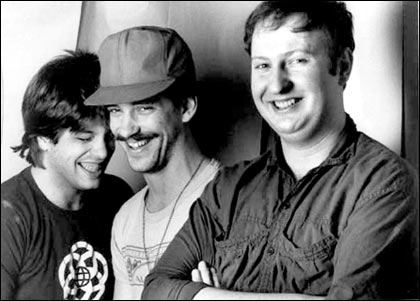
Hüsker Dü in 1986. Photo by Daniel Corrigan.
Related Story:
HAPPY BIRTHDAY TO THE (SECOND) GREATEST ALBUM OF ALL TIME
Grant Hart died in September, 2017. A few years ago, filmmaker Gorman Bechard released a movie about him. “Every Everything” is 93 minutes of Grant — and only Grant — proving himself to be one of the more oddly captivating storytellers you’ll ever have the pleasure of listening to.
Bechard had previously interviewed Grant for “Color Me Obsessed,” his film about The Replacements, and was taken with him. “Grant is one of the most influential musicians ever,” said Bechard at the time. “Beyond that, he’s as smart and funny as anyone on the planet.”
You may not be familiar with Hart, but he was among the most important songwriters of our time, and “Every Everything” is a brave and absolutely necessary tribute to one of the unsung heroes of modern music. Click the picture for more info…
— The one song I would probably have pruned from Zen Arcade is “Dreams Reoccurring,” the noisy little instrumental from side one. You’ve got the fourteen-minute version later on; do we really need this miniature version too? And the fact that “Indecision Time” isn’t so great either… it creates kind of a dead spot on the first side. In its place I’d have put “Some Kind of Fun,” one of the outtakes.
— The greatest concert I ever attended was an impromptu Husker show at a place called Harvey Wheeler Hall, in Concord, Massachusetts, on December 30th, 1984. It was a last-minute gig arranged by David Savoy, a Concord native who also was the band’s manager at the time (and whose suicide a few years later was partly responsible for its breakup). There was no stage; the band set up on the floor of what, in my memory, was a simple classroom. There were fewer than a hundred people there, and we stood or sat cross-legged. The set ended when Grant cut his finger on a cracked drumstick during a cover of the Beatles’ “Ticket to Ride.” My best friend at the time, Mark McKay (who later became the drummer for the post-hardcore band Slapshot), gave him a band-aid. When it was over we went backstage, as it were, and chatted a while with the band.
— A few years ago, Paul Hilcoff, the curator of the painfully exhaustive Hüsker Dü fan site, mailed me a compact disc recording of that entire concert. I had no idea there was one. What a startling feeling it is to discover, many years on, that a recording exists of one of your most cherished memories. Except, the CD still sits on my bookshelf, as yet unlistened-to. One of these days I’ll summon up the courage to actually play it. Listening to that recording, provided I’ve got the emotional muster, will be the closest I ever get to time travel.
— I once played Frisbee with Bob Mould. June 21, 1984, it was, prior to a show in Easthampton Massachusetts. There were four of us playing: me, Bob, a local Boston fanzine writer named Al Quint, and the aforementioned McKay.
— I once got to meet and shake hands with Bob Mould’s parents. It was that same summer of ’84, in Rhode Island. Mom and dad were touring the country, stopping in on the band’s performances. Bob himself introduced me to them.
— Greg Norton once sat patiently backstage while I peppered him with inane questions for a fanzine article I was writing.
— It was Grant, though, who was always the friendliest and most approachable of the three. I remember a night, between sets down at The Living Room in Providence, chatting with him in the parking lot. He was snacking on slices of cheese, when a stray dog came ambling over. Grant shared his cheese with the dog, holding up small bits of it, ever higher, making the dog jump for them.
— That was the same show in which Mould, rushing toward the stage for an encore, smashed his head against a ceiling rafter so hard that you could hear it from the parking lot. I have a feeling he remembers that.
GREATEST HITS, MOULD:
1. Eight Miles High (single)
2. Chartered Trips (Zen Arcade)
3. I Apologize (New Day Rising)
4. Gravity (Everything Falls Apart)
5. Crystal (Candy Apple Grey)
6. Real World (Metal Circus)
7. Makes No Sense at All (Flip Your Wig)
8. Celebrated Summer (New Day Rising)
9. Perfect Example (New Day Rising)
10. All This I’ve Done For You (Candy Apple Grey)
GREATEST HITS, HART:
1. Keep Hanging On (Flip Your Wig)
2. Terms of Psychic Warfare (New Day Rising)
3. Pink Turns to Blue (Zen Arcade)
4. Books About UFOs (New Day Rising)
5. It’s Not Funny Anymore (Metal Circus)
6. She’s a Woman [And Now he is a Man] (Warehouse: Songs and Stories)
7. Standing by the Sea (Zen Arcade)
8. Diane (Metal Circus)
9. The Girl Who Lives on Heaven Hill (New Day Rising)
10. Sunshine Superman (Everything Falls Apart)
Now if you’ve stayed with me this far, chances are you’re a pretty big Hüsker fan who won’t mind if I push things an obsessive step further. For you I present the following addendum. You’ve been warned:
I was looking at some photos of Hüsker Dü in their heyday, circa ’84 or ’85. These guys were, to put it one way, well-fed. Greg always kept himself trim and dapper, but Bob and Grant weren’t going hungry, that’s for sure.
It’s only fair, then, that we should revisit the Hüsker discography, making note of various song titles as they should have appeared. That is, with a gastronomical theme…
There’s little on Land Speed Record or Everything Falls Apart to cook with, so let’s start with Metal Circus. Here, Bob sets the table with “MEAL WORLD,” then takes his place in the “LUNCHLINE.” Grant tells us “I’M NOT HUNGRY ANYMORE,” but later opts for some delicious “STEAK DIANE.”
Zen Arcade is a veritable buffet line of fatty faves: Bob cooks up some “CHARRED TIPS.” Later he orders some “PRIME” down at the “NEWEST EATERY.” He’s got a sweet tooth for “THE BIGGEST PIE.” Alas, it’s a “BROKEN COOKIE, BROKEN HEART.” Grant warns that he’s “NEVER COOKING FOR YOU AGAIN,” yet later we find him “STANDING BY THE STOVE,” dreaming of that moment when “BEEF TURNS TO STEW” (“…waiters placing, gently placing, napkins round her plate.”) This is a very long album, and indigestion sets in by the end of side four, closing with the epic, flatulent jam, “REOCCURRING BEANS.”
Prior to Zen Arcade, you might remember, came the Huskers’ famous 7-inch single — its cover of the Byrds’ — or is it Birds’ — classic, “EGGS PILED HIGH.”
On New Day Rising, Grant tells us about “THE GIRL WHO WORKS AT THE BAR & GRILL,” followed on side two by the sugary “BOOKS ABOUT OREOS.” Bob serves up a “CELEBRATED SUPPER.”
Flip Your Wig is, let’s just say, a little thin, though Grant gives us a cooking lesson with “FLEXIBLE FRYER.”
On Candy Apple Pie… er, Gray … again its Grant with the big appetite. His two meaty singles are, “DON’T WANT TO KNOW IF YOU’RE HUNGRY,” and “HUNGRY SOMEHOW.”
The band’s final course is the delectable double LP: Steakhouse: Songs and Stories. Bob sings of “THESE IMPORTED BEERS,” before going gourmet on the plaintive “BED OF SNAILS.” Alas, he has “NO (DINNER) RESERVATIONS.” Grant snacks on some “CHARITY, CHASTITY, PEANUTS AND COKE,” and reminds us that “YOU CAN COOK AT HOME.”
Cockpit Confidential
Patrick Smith and Sourcebooks are proud to announce publication of the second edition of
Cockpit Confidential:
Everything You Need to Know About Air Travel.
Questions, Answers & Reflections
NOW A NEW YORK TIMES BESTSELLER
The original version of Cockpit Confidential was published in 2013. Suffice it to say the world of air travel has seen major changes since then. All seven chapters have been updated, revised, and in some cases totally rewritten. Approximately 20 percent of the text is all-new.
“Brilliant is the word that applies. A book to be savored and passed to friends.”
— William Langeweische, Vanity Fair
A wry, thoughtful, and at times provocative look into the confounding world of commercial air travel, this is the ideal take-along for frequent flyers, nervous passengers, world travelers, and anybody yearning for an enlightened, behind-the-scenes look at the strange and misunderstood business of commercial aviation. More than just a book about flying, its subject is everything and everything about the grand theater of air travel, from airport architecture to terrorism to the colors and cultures of the world’s airlines.
Patrick Smith has been called the thinking man’s pilot. For the better part of a decade, his Ask the Pilot column at Salon.com was a singular and remarkable sensation: an aviation column, for heaven’s sake, that could offer up trenchant analysis of an air disaster one day, then the next day stride fearlessly into politics, culture, or even rock music, and somehow tie it all together. Cockpit Confidential features the best of that material, refreshed and adapted into a seven-chapter volume of FAQs, essays and personal memoir. Whether it’s the nuts and bolts of cockpit operation or a hilarious critique of airline logos and color schemes, Cockpit Confidential is smart, funny, and brimming with useful information.
“Nobody covers the airline experience like Patrick Smith. And, he’s a damned good writer.”
— Clive Irving, Condé Nast Traveler
• How planes fly, and a revealing look at the men and women who fly them
• Straight talk on turbulence, pilot training, and safety
• The real story on congestion, delays, and the dysfunction of the modern airport
• The myths and misconceptions of cabin air and cockpit automation
• Terrorism in perspective and a candid look at security
• Airfares, seating woes, and the pitfalls of airline customer service
• The colors and cultures of the airlines we love to hate
• The yin and yang of global travel
• Gratuitous references to 80s-era indie rock bands
“Cockpit Confidential is the document that belongs in the seat pocket in front of you.”
— David Pogue
Look for the “Revised & Updated” seal in the upper left corner.
AVAILABLE IN PRINT, AUDIO, AND EBOOK FORMATS…
IN THE U.S.
IN CANADA
IN THE U.K. AND IRELAND
IN AUSTRALIA
IN INDIA
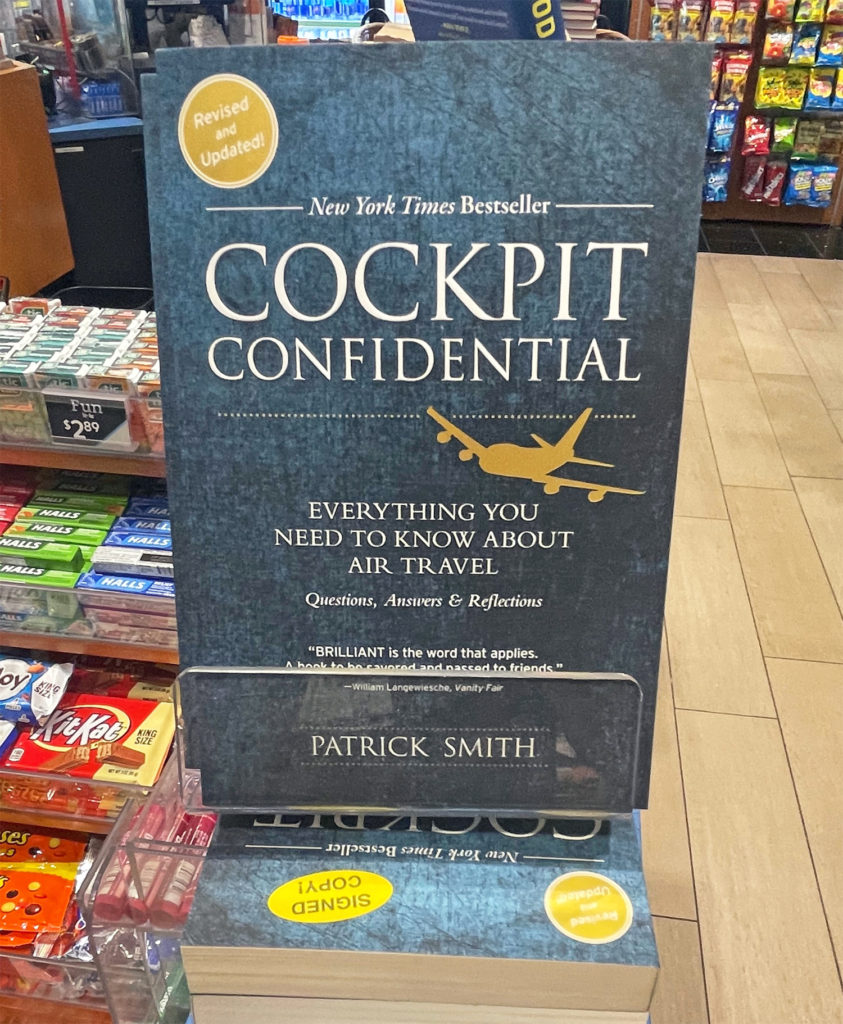
The Mad, Mad Summer of 2022
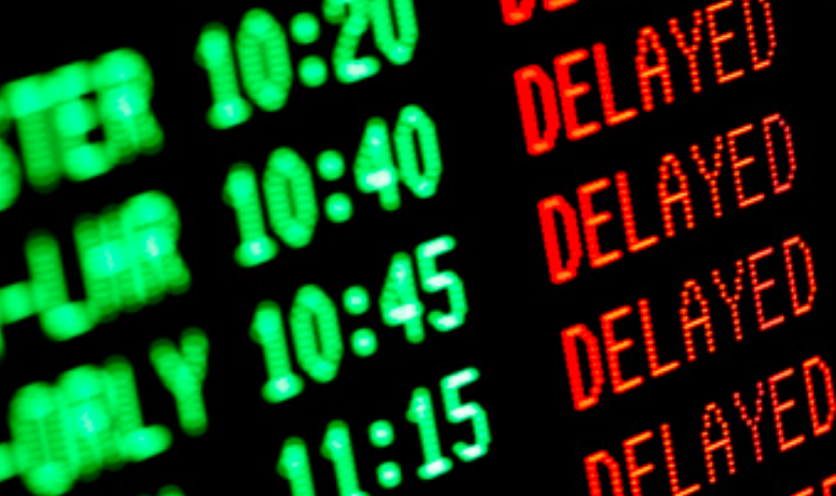
June 27, 2022
IF YOU’VE been to the airport lately, you’ve experienced the mayhem. Terminals are swamped, planes are overbooked, cancellations are rampant, delays are out of control.
I’ve been working quite a bit over the last few months, so I’ve been in the thick of it. “Travel is back,” I wrote in a post back in May. “I wasn’t sure we’d get here, so count me among those who are happy to see a little chaos again at the airport.” I meant what I said, but things have rapidly reached a breaking point. How bad is it, exactly? It’s tough to quantify in terms of statistics, but suffice it to say that in 30 years of commercial flying, I’ve never seen anything like this.
The gist of the problem is staffing. The media keeps talking about a pilot shortage, and certainly that’s a factor, but the crisis extends across the entire industry: at the airlines and their various contractors, at air traffic control, security, airport retail, and so on.
Yes, it mostly goes back to how things were handled at the height of the COVID-19 pandemic, when thousands of employees were shed, and a failure to adequately re-staff as things swung back to normal. On the surface, the airlines and their partners look pretty stupid, but perhaps it’s not that simple. Remember the environment at the height of COVOD-19 downturn. The industry had never faced anything like it, and was desperate to stay alive. There was no way of predicting when, or to what extent, flyers would return. Travel restrictions and border closings changed week to week, and absolutely nothing was certain. Almost nobody predicted a return to 2019 numbers so soon. The expectation, so much as there was one, was of a gradual, incremental return over a period of years.
Air travel logistics are challenging enough in normal times, never mind when the entire world has flipped upside-down. When it came to aligning their fleets and staffing, they did what they calculated was the smartest thing to do. Some guessed better than others. And that’s what it was to a big degree: guesswork.
And so here we are. And it’s not just the United States. Security and check-in lines at some European airports are three or more hours long. I was flying out of Dublin the other day, and the lines for U.S. immigration preclearance snaked all the way to the second floor. Amsterdam-Schiphol has enacted flight restrictions, and a luggage system meltdown at London-Heathrow left passengers without their bags for several days.
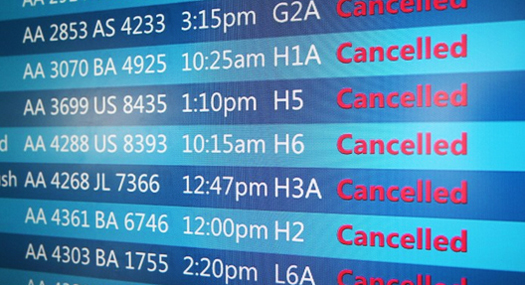
As to that pilot shortage we keep hearing about, there are, in fact, two shortages, the effects of which are overlapping. One is short-term and pandemic-related, per above. The second is more systemic and longer term.
Carriers are now taking on hundreds of new-hire pilots every month. This, combined with the lingering effects of the pandemic reshuffling, finds training departments overwhelmed, with long backlogs for classroom time, simulator slots, line certification flights, etc. Pilot training is modular, and it does not happen quickly. New-hire training can take several weeks, as can moving from one aircraft type to another, or upgrading from first officer to captain. Many pilots are sitting at home, waiting their turn. Thus, it’s less a dearth of pilots than a training system overload.
Then we have the other, more systemic shortage. As I talked about in this older article, this is a significantly bigger problem at the regional carrier level than at the majors. All of the legacy airlines are currently hiring, and although they’re having no trouble filling their slots, those pilots have to come from somewhere. This is causing a ripple effect downward through the industry. The regional sector has all but reinvented itself in a plea for new-hires, offering salary and benefits packages heretofore unheard of for entry-level airline pilots.
For decades, the salaries and working conditions at regional carriers were laughably substandard. In many cases pilots were asked to foot their own training costs, only to earn poverty level wages in return. And as the regional sector expanded, taking over more and more mainline flying, a job at a regional often meant an entire career at a regional. This led to fewer and fewer pilots getting into the business, helping create the shortage we have today. These companies now have little choice but to significantly improve pay scales and benefits, both to entice new-hire pilots and to retain the ones they already have. You could say they had it coming; there never needed to be a shortage in the first place.
Overall passenger numbers are still off about 15 percent from 2019. The problem is, the 85 percent who are back are being crammed into an infrastructure that can’t handle them.
What nobody is talking about, meanwhile, is the issue of airspace and runway saturation. It was bad enough pre-pandemic. Now, several upstart carriers are pumping even more airplanes into a system at or beyond maximum capacity. It’s especially bad in the eastern half of the U.S. Things run fairly smoothly when the weather is good, but the minute a storm develops, blocking off air routes, the delays and cancellations start to cascade.
Even on clear-weather days, the taxiway queues at airports like Newark or La Guardia can be hours long. Airlines need to better rationalize their schedules and, in many markets, consolidate departures to help reduce congestion. To this end, the short-haul widebody jet is a concept whose time has maybe returned.
When will the madness end? Will it end? I keep my fingers crossed that we’re not being set up for a sort of new normal in which chaos is taken for granted. I worry, because as we’ve seen with airport security over the past two decades, the traveling public has a remarkable and discouraging ability to adapt to almost anything, no matter how absurd or inconvenient.
Let’s hope, instead, the crisis is temporary. I suspect things will improve as demand dies down after Labor Day. In the meantime, if you bring one thing to the airport this summer, have it be this: patience.
Related Stories:
THE MELANCHOLY OF AN EMPTY AIRPORT
BIG PLANES, SHORT ROUTES. WHAT A CONCEPT.
FACT AND FALLACY OF THE PILOT SHORTAGE
Here Comes the Summer
May 15, 2022
AIRLINES are understaffed, employees are overworked, passenger volumes are back to pre-pandemic levels, masks are off. And here come the three busiest travel months of the year. We’re already at the ragged edge of the envelope; just wait until those midsummer thunderstorms start barreling in. It’s going to be messy. If you bring one thing to the airport this summer, have it be this: patience.
I’m not the only one sounding the alarm. The major media, along with all the travel blogs, have been putting out their warnings as well. I like to believe that precisely because there’s so much hype, chances are things won’t turn out as bad as everyone says. So think of this post as a kind of reverse jinx. I’ll be traveling a lot in the next few months, and would prefer to keep my frazzle levels low.
Part of the mess is due to an ongoing pilot shortage, as I’m sure you’ve heard. In fact there are two pilot shortages, the effects of which are overlapping. One is short-term and mostly the result of poor planning. The second is more systemic and longer term.
When I say “poor planning,” I’m talking about the industry’s failure to adequately re-staff as things swung back to normal. However, while on the surface the airlines look pretty stupid, it’s not that simple: Consider the environment at the height of COVOD-19 downturn. The industry had never faced anything like this, and was desperate to stay alive. There was no way of predicting when, or to what extent, flyers would return. As the virus ebbed and surged, travel restrictions and border closings changed week to week; absolutely nothing was certain, and almost nobody predicted a return to 2019 numbers so soon. The expectation, so much as there was one, was of a gradual, incremental return.
Air travel logistics are challenging enough in normal times, never mind when the entire world has flipped upside-down. When it came to aligning their fleets and staffing, they did what they calculated was the smartest thing to do. Some guessed better than others — and that’s what it was to a big degree: guesswork.
Airlines are now taking on hundreds of new-hire pilots every month. This, combined with the lingering effects of the pandemic reshuffling, finds training departments overwhelmed, with long backlogs for classroom time, simulator slots, line certification flights, and so on. Many pilots are sitting at home, waiting their turn. Thus, it’s less a dearth of pilots than a training system overload.
Then we have the other, more systemic shortage. As I talked about in this older article, this is a significantly bigger problem at the regional carrier level than at the majors. All of the biggest airlines are currently hiring, and although they’re having no trouble filling their openings, those pilots have to come from somewhere, with high requisite levels of skill and experience. This is causing a ripple effect downward through the industry. The regional sector has all but reinvented itself in a plea for pilots, offering salary and benefits packages heretofore unheard of for entry-level airline pilots.

What nobody is talking about, meanwhile, is the issue of airspace and runway saturation. This is an even bigger factor than anything related to labor. Airlines continue adding planes into a system already at maximum capacity, especially in the eastern half of the U.S. It was bad enough pre-pandemic. Now, several upstart carriers are pumping even more airplanes into the sky.
Things run fairly smoothly when the weather is good, but the minute a storm develops, blocking off air routes, the delays and cancellations start to cascade. There’s no slack, no logistical breathing room. Even on clear-weather days, the taxiway queues at airports like Newark or La Guardia can be hours long.
It’s hard to say to what impact all of this will have on the summer of 2022. Pilots are just one of the moving parts.
Things might get messy, no doubt. But try to look at the bright side: People are out and about. Borders and attractions are (mostly) open. Travel is back. I wasn’t sure we’d get here, so count me among those who are happy to see a little chaos again at the airport.
“Here Comes the Summer” is a horrible song by the Undertones. Here’s a better one.
Related Stories:
THE MELANCHOLY OF AN EMPTY AIRPORT
BIG PLANES, SHORT ROUTES. WHAT A CONCEPT.
FACT AND FALLACY OF THE PILOT SHORTAGE
Rarefied Air
April 21, 2022
FLY ENOUGH, and every so often you’ll encounter this or that famous — or infamous — person.
Maybe it’s a pop star. Maybe a film star. Maybe a newscaster, an athlete, or a washed-up comedian nobody remembers (see below). Maybe it’s 1981 and you’re a ninth-grader, standing in baggage claim at the Los Angeles airport, and the actor known as “Mr. T” walks past you with his entourage.
As a pilot, I have the added thrill of not just seeing or perhaps sharing a row of seats with whomever it is, but being somewhat indispensable to whatever journey he or she is embarking on — be it a flight home from an awards show or a trip to rehab. They’re counting on me.
Or so it’s fun to think…
The thing about Mr. T is that he was short. Or shorter than he should have been, as I understood it. There’s always something about a celebrity that catches you off guard.
Spike Lee was on board once. This was a shuttle flight from Boston to La Guardia. Lee also is on the shorter side, but I knew that ahead of time.
Kevin McHale, the Hall of Fame basketball star from the Boston Celtics, is not short. One afternoon I was working a flight from Atlanta to San Francisco, and Kevin was sitting in first class. “You and me go way back,” I said to him. This was a reference to the days in the early 1980s when I followed every Celtics game, and McHale was the power forward of the team’s “big three” attack, along with Larry Bird and Robert Parish.
(As it happens, some years ago I was waiting to appear on a local television show, and I shared the green room with none other than Robert Parish. It was just the two of us, and we chatted for a few minutes. That was cool.)
About two months after the flight to San Francisco, I was standing at the gate in Boston waiting to board a plane to JFK, when I looked over and there, again, was Kevin McHale. “Hey!” I said. “I flew you out to San Francisco a couple of months ago!”
Kevin McHale didn’t seem impressed. I guess I don’t blame him.
Another time it was Dan Rather. “What’s the frequency, Kenneth?” I said to the captain. He didn’t get the joke. You probably don’t, either. It’s an old reference.
Dan Rather is old. I’m old. Everyone is old.
Kirk Douglas was certainly old. He lived to be 103. And although I never met or flew Kirk Douglas, I did carry his famous son, the actor Michael, on a run from JFK to LAX. I learned later that Michael had been en route to his father’s centennial birthday celebration.
I knew who Michael Douglas was right away, but in general my celebrity recognition skills are poor.
Kanye West was on my plane coming back from Zurich. I remember he walked aboard carrying a glass of cognac that he’d taken from the lounge. I was standing near the doorway, and as he passed I made some goofy remark about people bringing drinks onto planes. A flight attendant took me aside and told me the guy was Kanye West. I had only the vaguest idea who Kanye West was, and until that moment couldn’t have told you what he looked like.
Another night, there was a buzz among the cabin crew because “one of the Kardashians” was sitting in row two. I seemed to be the only person on the plane who didn’t know what a Kardashian was. I’d heard the name enough times, sure, but it didn’t mean much to me. I knew they were a celebrity family for some bizarre reason — though, to me, the name has always makes me think of an arms dealer or a Wall Street villain. When I looked over at row two, I saw a pleasantly dressed woman reading a magazine. This was a Kardashian?
Which one was it? I don’t remember.
At the gate in Los Angeles one morning, a couple come aboard and take their place in business class. They have a kid with them, a toddler. They’re conspicuous for a few different reasons. For one, their clothes and haircuts are — I don’t know how to describe it, exactly. Flamboyant, I guess is the word. The woman has plumes of hair going in all directions, like Sideshow Bob. The kid, who is maybe three, has a miniature version of the same hair, but in a more vertical, mohawk style. He’s wearing a brightly striped onesie outfit that appears to be made of silk. He’s kicking and fussing and screaming. Later I’m told that that the woman is the singer Alicia Keys, and the little troublemaker is her son.
Would you recognize the former news anchor Katie Couric? I didn’t, but she was on my plane a few years ago, and, long story short, ended up borrowing my iPhone charger. I gave Ms. Couric my card and told her to let me know if ever she needed help with a story about airplanes or airlines. One morning, not long afterwards, she called me at home, with questions about something that had been in the news. I forget what the topic was, and nothing ever came of it.
I flew the actor F. Murray Abraham out of Bucharest, Romania. This was a big one for me, because Abraham has the starring role in what, to me, is the funniest scene ever filmed for television. I’m talking about the Russian Tea Room scene with Louis C.K. during season three of the show “Louie.” You can view it here. The genius of this scene can’t be overstated. I wanted to tell the actor that, but I kept my mouth shut.
I did not keep my mouth shut the afternoon I flew Anthony Bourdain from Ireland to the U.S. This was in 2012, shortly before my book was published. The title of my book is, of course, a derivative ripoff of Bourdain’s famous book, “Kitchen Confidential.” I’d always felt uneasy about this, and here was my chance to let Mr. Bourdain know. “The publisher forced it on me,” I said to him, lying through my teeth.
He laughed.

And we haven’t even gotten to presidents…
I’ve met three presidents. None of them American presidents, but presidents nevertheless. The first of them was John Atta Mills, the semi-beloved leader of Ghana. Mills died in 2012, but during his tenure he rode aboard my airplane at least twice.
I also had the honor of meeting and flying the President of Guyana, Bharat Jagdeo. (Contrary to what my father and others seem to think, Ghana and Guyana are in fact different countries, on different continents, with different presidents to boot.)
Third on the list is Ellen Johnson Sirlief, Nobel Peace Prize laureate and former President of Liberia. I met her four times, including once at a reception at Roberts Field. On one of those occasions, I asked if she’d be kind enough to sign a copy of our flight plan. She obliged, writing her name in green ink at the bottom of the dot-matrix printout.
Things have worked out well for me, I think. Years ago, when I was puttering around over Plum Island, sweating to death in some noisy old Cessna, the idea that one day I’d be be carrying presidents in the back of my plane would have struck me as ludicrous.
Next we have the would-be presidents…
Doing this chronologically, we have to go all the way back a weekend afternoon in 1980. I’m at Boston’s Logan Airport, planespotting with a pair of my junior high pals, when who disembarks from a TWA jet only a few feet in front of us but Jerry Brown, then-governor (and, later, governor again!) of California. Brown was running for President that year along with Jimmy Carter, John Anderson and Ronald Reagan.
In addition to his political aspirations, Governor Brown, a.k.a. “Governor Moonbeam,” is known for his dabbling in Buddhism, his long liaison with Linda Ronstadt, and his appearance in one of the most famous punk rock songs — the Dead Kennedys’ “California Über Alles.”
Six years after that, on a Sunday morning in 1990, I’m standing at Teterboro Airport, a busy general aviation field in New Jersey, close to New York City. A private jet pulls up. The stairs come down, and out steps Jesse Jackson and several burly bodyguards. Jackson walks into the terminal, passing me by inches.
The following summer I’m back at Logan, using a payphone in Terminal E. Suddenly Ted Kennedy is standing at the phone next to me, placing a call. (Quaint, I know, in this age of wireless, but there’s the famous Senator, the brother of JFK, slipping dimes into the slot.) I’m talking to a friend, and I surreptitiously hold up the receiver. “Listen,” I say, “whose voice is this?”
“Sounds like Ted Kennedy,” she reckons. And it is.

Next it’s 1994. Logan again, and I’m in the captain’s seat of a Northwest Airlink 19-seater, preparing for departure to Baltimore. Up the front stairs comes Michael Dukakis, who in 1988 had lost the election in a landslide to George Bush the Elder. He stops briefly behind the cockpit and says hello.
After we land in Baltimore, Dukakis thanks us for the ride and remarks, “Not a lot of room in here.” Even at 5’8″ he’s right about that. The Metroliner’s skinny, tubular fuselage earned it the nickname “lawn dart.”
“Yeah,” I answer, “It’s not exactly Air Force One.”
Meanwhile, intentionally or otherwise, the Duke has left a sheaf of important-looking papers in his seat pocket — probably because he’s run to a phone to cuss out his secretary for booking him on that stupid little plane with the annoying pilot. I carry the papers inside to the counter. “Here,” I say to the agent. “These belong to Mike Dukakis.” She looks at me like I’m crazy.
In 2012 I shared a shuttle flight from New York to Boston with Chelsea Clinton. She and her husband were sitting just a few rows ahead of me. At one point I was taking something down from the overhead locker when she passed me in the aisle. I was in her way and had to move aside. “Sorry,” I said. “Excuse me.”
“Thanks,” said Chelsea Clinton.
All of those people were Democrats. Rounding things off ideologically, I once had the controversial Supreme Court nominee Robert Bork on my plane. That was in the summer of 1991. Bork was riding in my rattletrap 15-seater from Boston to Nantucket.
That same summer, again to Nantucket in the same shitty plane, I flew David Atkins, better known to the world as “Sinbad,” the thankfully-forgotten actor and comedian who once had his own talk show and HBO comedy special. He sat in the back row of the Beech-99, surrounded by an entourage of beautiful women.
Okay, “thankfully-forgotten” is a cruel thing to say, even if he did wind up emceeing the Miss Universe pageant. Sinbad couldn’t have been friendlier, and in the Compass Rose restaurant at the Nantucket airport he bought me and my copilot chicken sandwiches, asking us for advice on what kind of airplane he should buy. We told him to invest in a Cessna Citation — a twin-engine executive jet — though I can’t remember why. I was making about thirteen grand a year at the time, and would have said anything for a chicken sandwich.
The great New York Yankees catcher Thurman Munson was killed at the controls of a Cessna Citation in 1979, but I don’t think we mentioned this to Sinbad.
Related Stories:
Unmasked

April 19, 2022
IF YOU’RE headed to the airport today, you can leave your face covering at home.
Yesterday, a Federal judge struck down the Biden Administration’s extension of the TSA-enforced mask mandate for airports, airplanes, and public transit. By late afternoon, the White House basically threw in the towel, announcing that TSA would no longer enforce the rule. Already extended on two prior occasions, the mandate was set to expire in under three weeks. Apparently this wasn’t a fight worth taking on.
Within hours, the country’s airlines began informing passengers and employees that, effective immediately, masks are now optional.
The new policy will affect U.S. domestic flights and airports. Protocols on international flights will vary with the destination country.
Here’s hoping the pre-departure testing requirement for passengers returning to the United States is next to be eliminated.
Regardless of where I fall on the matter, what I fear is that the to-mask-or-not-to-mask question becomes a kind of binary political litmus: if you’re politically on the left, you’ll continue wearing a mask. If you’re a Trumper or politically to the right, you won’t. Ideological affiliations will thus be judged instantly, based on appearance.
This kind of non-thinking is bothersome and very unfair, but this is the nation we’re living in these days — and another of the reasons I’ve come to feel so politically homeless of late.
And that’s about all I wish to say. If readers feel like arguing the good and bad, have at it in the comments section.
It’ll be interesting to see this how this plays out. I imagine the percentage of people sticking with masks will, at first, remain quite high. I was at the Dublin airport a couple of weeks ago, where the policy has been optional for a while, and it was about 50/50. Will you wear a mask still? Why or why not? And talk us through the different scenarios. What if, for example, you prefer to be masked but find yourself seated in a row of unmasked flyers. Etc.
One thing that hopefully goes away forever are the mask selfies on Instagram posted by pilots and flight attendants. If, like me, you’re a fan of the various commercial aviation photostreams, you’ve seen them: picture after picture of airline workers cheerfully mugging in face masks. This seems wrong to me, and often smells sanctimonious.
And why do I get the feeling that most of these photos would never exist in the first place if not for the masks? Somehow the mask seems to be the entire point, which makes it all the more frustrating.
Yes, until now, everyone who flew needed to put a mask on. This was understood and accepted, as was any airline’s attempt to make the policy clear through advertising, promotional materials, on-board safety videos, and so forth. What’s driven me crazy, however, have been the constant attempts to cute-ify the wearing of masks. Because, in fact, there’s nothing cute about them. Masks are physical symptom of a society in pretty serious distress. This isn’t something to giggle at, normalize, or make light of.
Related Stories:
A PILOT’S LIFE UNDER COVID
CORONAVIRUS CASUALTIES
HOTEL ROOM MADNESS
DEPARTURE TESTING MADE EASY
Switched Off
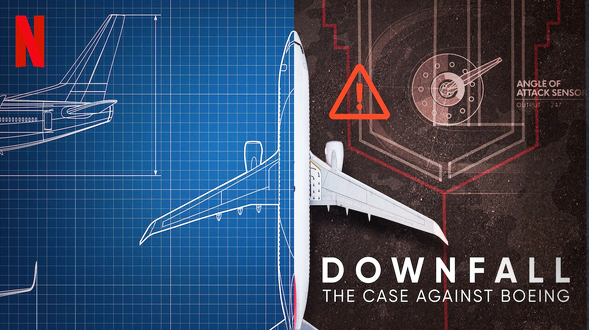
April 14, 2022
I’M SUPPOSED to watch the much talked-about documentary, “Downfall,” about Boeing and the 737 MAX fiasco, and report back to you with my thoughts. The show keeps popping up in my Netflix stream. But I end up watching “Better Call Saul” instead.
As a general rule I shy away from aviation-related shows. Inevitably they’re over-the-top, misleading, or incomplete. They leave me annoyed and wanting to write letters to the producers. So, no, I haven’t seen “Downfall” and I have no plans to.
That’s not to say all such programs are poorly made. Comments I’ve heard from other pilots suggest they did a good job with this one. Which is nice to know, but still I’m in no hurry to find out. Plus, they didn’t invite me on the show.
Had they interviewed me, I would have voiced my opinion that central to Boeing’s boondoggle with the MAX was its decision to not build the 797. Instead of coming out with an all-new mid-sized airframe to replace its aging 757 and 767 models, they opted to force-feed the industry monsterized versions of the 737. Plans for the 797 should have been unveiled on the day the 757 went out of production, eighteen years ago.
Boeing claimed there wasn’t a big-enough market for such a jet, which is nonsense. The order backlog for advanced versions of the Airbus A321 proves it. The A321 isn’t half the plane the 797 would have been, but it’s the only one that sort of, kind of, fills that capacity and range niche. Hopefully “Downfall” at least touched on this.
Instead of me reviewing the program, I’ll let you do it, in the comments section below. Let us know what was good, bad, depressing, pleasing or disappointing. Maybe, even, you’ll convince me to watch it.
Related Stories:
BOEING’S BELEAGUERED JETLINER
THE PLANE THAT NEVER WAS.
ODE TO THE 757
The China Eastern 737 Crash
March 22, 2022
FIRST THINGS FIRST, it’s important to employ my usual post-crash disclaimer: When planes go down, initial speculation is often misguided and wrong. Early clues that appear straightforward and revealing turn out to be complicated and unclear.
All we know for certain is that China Eastern flight 5735 was cruising at 29,000 feet when something went disastrously awry. The jetliner, with 132 people aboard, fell into a high-speed plunge. Radar reports show that it leveled off briefly at around 8,000 feet, began a brief climb, then fell into a second plunge from which it never recovered, disintegrating into hilly terrain near the city of Wuzhou. There were no survivors.
The severity of the plunges, which were tracked by air traffic control radar, together with harrowing security camera footage showing the stricken jet in a vertical dive, offer some of those clues that we need to be careful with. Whatever went wrong, it happened quickly and catastrophically. There was no distress call.
This tells us a lot, but also it tells us nothing. Any number of things is possible, from a bomb to a flight control system somehow gone haywire. One cause being thrown around is “structural failure.” Did some portion of the tail or a stabilizer separate from the aircraft? Perhaps. But if so, why? Design flaw, faulty repair, explosive decompression? There can be layers to these things.
That the descent was temporarily arrested is the most interesting part. It suggests the pilots were able to maintain or regain some semblance of control, at least briefly. This lessens the probability of certain scenarios — a bombing or major structural failure, for example, the results of which tend to be a more consistent sort of plummet. Yet nothing can be ruled out entirely. A friend of mine even came up with a pilot suicide hypothesis that, although extremely unlikely, is nonetheless plausible
The plane was a Boeing 737-800. The -800 is one of the “Next Generation” (NG) 737 variants. It first flew in 1997, and today is one of the most popular jetliners in the world.
The 737-800 is not equipped with the stall avoidance system that led to the 737 MAX crashes a few years ago, but the jet has had a few problems over the years:
In 2005, a group of former Boeing employees filed a lawsuit claiming that some Next Generation 737s had been manufactured with defective parts. These parts, it was contended, may have contributed to the fuselage breakups of a Turkish Airlines 737 outside Amsterdam in 2009, and the nonfatal runway overrun of an American Airlines 737 in Jamaica that same year. The ex-employees lost their case, as well as their appeal. Investigators, including the NTSB, found no link between faulty parts and structural failure.
In 2019, fatigue cracks were discovered in the wing-fuselage attachment sections of approximately five percent of the global 737NG fleet, leading to a series of mandated inspections and repairs. But this applies primarily to older -800s that have exceeded a particular number of flight hours and cycles (takeoffs and landings). The airplane that crashed in China was only seven years-old.
A rudder defect was blamed for at least two 737 disasters in the 1990s, plus a number of nonfatal incidents. These were earlier-generation variants, however, and the plane’s rudder servo system was redesigned.
You might also come across articles highlighting the high number of incidents and accidents involving 737s over the decades. Be wary of how these numbers are presented (usually as raw totals, without meaningful statistical context), keeping in mind that more 737s have been built than any other jet.
And so, there’s nothing at this point to suggest flight 5735 was brought down by a design flaw or potential negligence on the part of the manufacturer. And while I’ve never been much a fan of the 737, it’s not because I consider the plane unsafe. No matter, the wolves are out for Boeing, and have been since the MAX crashes. With the company’s reputation in tatters, this couldn’t have come at a worse time, regardless of who or what is to blame.
“Boeing Faces New Upheaval After Crash of Chinese Airliner,” read a headline in yesterday’s New York Times. “No fault has been found,” the article continues, “but the company, which has been trying to overcome a recent legacy of design and production troubles, is likely to get scrutinized.”
It certainly will be. But let’s maybe not go that route until the facts are in. We live in a time when everyone wants quick and concise answers, I know. But air crash investigations take months, sometimes years. Even then, we don’t always learn the whole story.
NOTES AND WHATNOT:
— China’s domestic airline market is roughly as large as that of the United States. Once much maligned, the country’s aviation safety record has improved considerably over the last two decades and is now considered among the safest. China’s last major accident was a decade ago.
— In the old days, China had only one airline: the Civil Aviation Administration of China (CAAC), which was second only to Aeroflot in size. And like Aeroflot, it was eventually broken up, splintering off dozens of smaller independent carriers. One of those was China Eastern. Based in Shanghai, China Eastern is today the country’s second-largest airline, just behind China Southern, with a fleet of some 600 aircraft and a route structure extending to Europe and North America.
— We can thank the security-industrial complex for these furtive glimpses of crashing planes we’d otherwise never see. Pentagon, etc. Now this one.
— Those puffs of smoke visible in the video look to me like engine compressor stalls. Jet engines will not function properly in a vertical dive, effectively hiccuping.
— One upon a time, a plane crash in a foreign country killing 132 people would have been a relatively minor news story. What happened is obviously tragic, but the amount of attention that crashes receive nowadays helps underscore how rare they’ve become.
RELATED STORIES:



